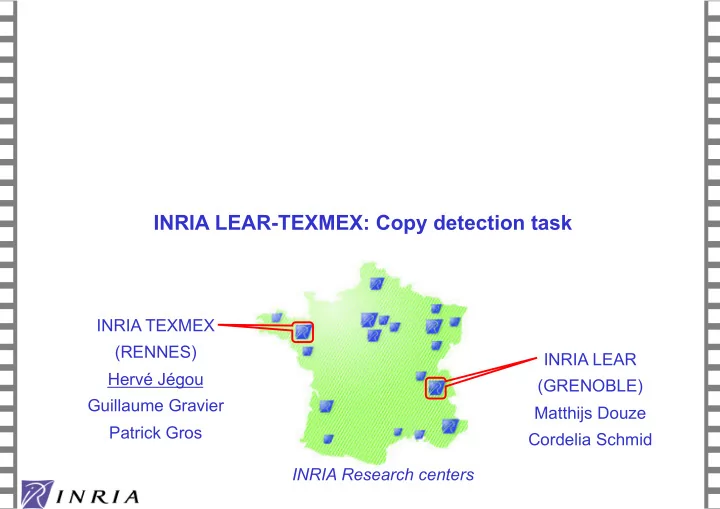

INRIA LEAR-TEXMEX: Copy detection task INRIA TEXMEX (RENNES) INRIA LEAR Hervé Jégou (GRENOBLE) Guillaume Gravier Matthijs Douze Patrick Gros Cordelia Schmid INRIA Research centers
Introduction INRIA participation in 2008: top results on all transformations focus on accuracy + localization ► Video: same system as in 2008: ► An image-based approach to video copy detection with spatio-temporal filtering Douze, Jégou & Schmid, IEEE Trans. Multimedia 2010 + parameter’s optimization ► Audio: new system (no audio in 2008’s evaluation) audio descriptors computed with standard package (spro) ► novel approximate nearest neighbor search method ► In this talk: brief overview of our video and audio systems ► focus on our ANN method ► comments on our results ►
Short overview of our video system: key components Local descriptors: CS-LBP Weak geometric consistency Heikkila et al., PR’2010 Jégou et al., ECCV’08 ► ► ANN search: Hamming Embedding Jégou et al., ECCV’08 Burstiness strategy + Multi-probe ► Jégou et al., ICCV’09 ► Score regularization: Spatio-temporal fine post-verification Douze et al., IEEE TMM’10 ►
Short overview of our audio system: key components Descriptors filter banks ► Compounding ► energy invariance ► 1 vector /10 ms ► online package: https://gforge.inria.fr/projects/spro, filter banks, MFCC, etc ► Novel ANN search based on compression paradigm: see next slides Temporal integration: Hough voting scheme (votes in histogram Δ t=tb-tq)
Video parameter optimization mAP on a validation dataset OBJECTIVE: improve precision with “reasonable” cost w.r.t. efficiency query database T200 T200 T200 Decreasing detector threshold +H200 +H100 number of descriptors ► T200 0.483 complexity ► T100 0.514 0.568 0.583 precision (with HE) ► threshold: T200 or T100 ► T100+flip 0.627 0.719 0.738 Describe flip/half-sized frames T100+flip, MA10 0.683 0.749 0.737 on database side only ► T100+flip, MA3 0.650 0.755 0.761 threshold: H200 or H100 ► Observation: Multiple assignment (=multi-probe) • half sized and flipped frame help a lot on query side only • small multi-probe (x3) is sufficient ► Note: generic system • only flipped is specifically to
Huge volumes to index: approximate nearest neighbor search index size (database) Video, T200 d=128 2.48 billion descriptors Video (half, H100) d=128 0.97 billion descriptors Audio d=144 140 million descriptors Need for powerful approximate search Locality Sensitive Hashing: memory consuming, need for post-verification on disk, not very good trade-off between precision/efficiency FLANN: excellent results, memory consuming, need for post-verification (on disk given the dataset size) We used: Video: Hamming Embedding with 48 bits signature (10B/descriptors+geometry) ► Audio: Compression based approach Product quantization method ►
Indexing algorithm: searching with quantization [Jegou et al., TPAMI’11] Purpose: approximate NN search with limited memory (and no disk access) Search/Indexing = distance approximation problem The distance between a query vector x and a database vector y is estimated by where q(.) is a fine quantizer → vector-to-code distance Distance is approximated in compressed domain typically 8 table look-ups and additions per distance estimation (for SIFTs) ► proved statistical upper bound on distance approximation error ►
Indexing algorithm: searching with quantization [Jegou et al., TPAMI’11] Combination with inverted file: coarse quantizer to avoid scanning all elements Here: MA=3 Fine representation: 2^64 centroids per cell (typically for SIFTs) Efficient search: searching in 2 billion SIFT vectors (with MA=1) This method: 3.4 ms / query vector ► HE: 2.8 ms / query vector ►
Comparison with FLANN [Muja & Lowe’09] Tested on 1 million SIFTs 1.5 to 2 faster than FLANN for same accuracy Memory usage for 1M vectors (according to “ top ” command): FLANN: > 250MB ► Ours: < 25MB ►
NDCR: Comparison between 2008 and 2010 2008 2010 Ranks / 22 participants (BAL, Opt_NDCR) Rank 1st 2nd 3rd 4th 5th # 6 10 19 18 2 Huh?! What’s the problem? “Bug”: a few false positive videos are returned frequently with very high scores ►
Results on Trecvid: sub-optimality of our approach Problem with audio: pseudo-white segments corrupts similarity measure Fusion based on invalid assumptions: two first runs: audio and video assumed to have similar performance ► two last runs: audio assumed to be better than video ►
Conclusion We have learned many things this year: actual decision threshold: need for « cross-databases » setting method ► audio helps a lot (when working) ► fusion module is very important ► audio ≠ video, room for improvement by score normalization strong bonus when both agree What’s might interest the other participants in what we have done approximate nearest neighbor method for billion vectors ► Online resources: spro: library for audio descriptors ► Matlab toy implementation of our compression based search method ► BIGANN: a billion sized vector set to evaluate ANN methods ► GIST descriptor in C: OK for several copy transformations ► [Douze et al., CIVR’09, IBM Trecvid’10]
Recommend
More recommend